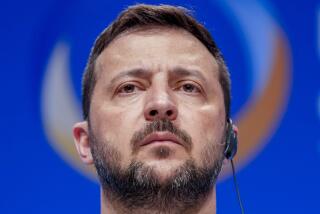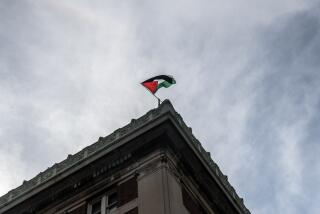The Curtain Rises: Eastern Europe, 1989 : CHAPTER 6 CZECHOSLOVAKIA : The Trickle Rapidly Grows Into a Torrent : Prague becomes the next escape route for fleeing East Germans. But their government remains paralyzed.
The hole was widening.
Within two days, 12,000 East Germans had crossed the Hungarian border into Austria and on to West Germany amid scenes of jubilation. By Sept. 20, the count was up to 20,000.
And now it was Prague. The buildup started slowly--there had been 60 to 70 East Germans in the West German Embassy in Prague as far back as June--but it was rapidly gathering strength. Since the Hungarians opened the border, reports persisted of Czechoslovak border guards roughing up East Germans trying to cross into Hungary, of East Germans drowning in attempts to swim the Danube between Bratislava and Esztergom, where the river forms the Czechoslovak-Hungarian border.
Now, East Germans were not bothering to go as far as Hungary. The closest West German embassy would do, and Prague, only 60 miles from the nearest East German crossing point, was it.
Michael Steiner, 40, was a second secretary at the West German Embassy, in Prague only since June and fresh from two years in New York at the United Nations. He had asked for the Prague assignment, chosen it because he was certain, sometime in the standard two-year diplomatic tour, “things were going to start happening” in Prague, and he wanted to be there to see it.
On Sept. 27, Steiner, like everyone else in the embassy, was going on cigarettes, coffee and adrenalin and looking out at a crowd of more than 2,500 East Germans inside the embassy compound. The hallways, stairs and formal reception rooms were jammed. The cable traffic said the West German Embassy in Warsaw had 400 East Germans waiting.
In the evening, as Steiner hurried about his errands and the crowd continued to grow, a fog of human heat rose over the embassy’s back garden, over the draped canvas of hastily erected tents, mingling with the mist and lantern light in the wet tree limbs. Three thousand, 4,000 of them--it was hard to count, they were everywhere--waited with their plastic suitcases and grimy backpacks and squealing children. Wet, sleepless, the East Germans waited for the word that would send them on their way, to the West; goodby to communism forever.
On the surrounding streets, their little boxlike cars were nosed in across the curbs, abandoned in driveways, under bridges, even under expressway overpasses. Sometimes, the East German auto ID tags were already scratched out, like a last insult flung over the shoulder.
In East Berlin, the authorities did not seem to have been jolted out of the bewildered paralysis that Gyula Horn, the Hungarian foreign minister, had discovered. On Sept. 25, Erich Honecker made his first public appearance since August, accepting the credentials of two newly arrived ambassadors. That same day, in the biggest demonstration in years, tens of thousands of people marched through Leipzig, calling for reforms and the legalization of a newly formed opposition group, New Forum.
The group had come into being only on Sept. 10 but already claimed it had between 5,000 and 10,000 members. Its application for registration had been denied by the Interior Ministry, which called its platform “subversive” and “anti-state.”
Now the Czechoslovak government was caught in the middle. Unlike the Hungarians, the Czechoslovak government was ideologically sympathetic to the East Germans and saw Honecker’s stubborn resistance to political reform as a bulwark for its own brass-knuckle policies. A threat to Honecker was a threat to Milos Jakes, the Czechoslovak party leader, whose claim to power rested solely on a 20-year dedication to exorcising any taint of liberalism from the party’s membership rolls.
Never known for their political agility, the Czechoslovaks could not provide consistent orders to Prague police units patrolling the narrow, sloping streets around the West German Embassy. For a time, they tried to bar access to the embassy, then they relaxed, then they tried again. In the end, they simply gave up.
In East Berlin, the pressure was intensified by the approaching 40th anniversary of the East German Republic on Oct. 7. Gorbachev himself was coming for the observances, along with Communist dignitaries from all over the East Bloc. It was shaping up as an event of high embarrassment.
More than 100,000 East Germans had emigrated already in 1989, 35,000 of them illegally. The country seemed to be hemorrhaging its population. The street demonstrations were growing daily in numbers and intensity.
To members of the East German government with a grip on reality--and these did not seem to include Honecker--if there was a limit to Soviet patience, East Germany must now be approaching it. Gorbachev had tolerated Honecker’s resistance to change and even, on occasion, his lectures on the proper course of socialism, as long as Honecker kept the lid on. But this was humiliation on an international scale, and Gorbachev could hardly be pleased.
On Sept. 27, West German Foreign Minister Hans-Dietrich Genscher and his East German counterpart, Oskar Fischer, were in New York for the U.N. General Assembly. Also attending was Eduard A. Shevardnadze, Gorbachev’s foreign policy chief. The Czechoslovak government announced in Prague that high-level international negotiations were under way. Shevardnadze’s involvement was crucial. He convinced Fischer that the East Germans should be allowed to leave Prague, and Warsaw, on “humanitarian grounds.” In the minds of seasoned diplomats, it was not a long-term solution, but the East Germans operated under the illusion that the problem would be eliminated.
Triumphantly, Genscher flew to Prague on Sept. 30 and appeared that night on the balcony of the West German Embassy to announce the decision. For 16 years, he had been West Germany’s foreign minister. He himself had escaped from East Germany in 1952. The cheers from the throng in the garden swept over him. Below, amid the tents of the muddy encampment, couples embraced and wept, fathers held small children aloft so that they could say, one day, that they had seen the historic moment. Genscher said it was the crowning hour of his public career.
The trains left from Prague the next day. The East German Foreign Ministry announced that, according to its interpretation of the agreement, the departing citizens would ride the trains through East German territory to the West and in the process would be “expelled” from East Germany. Those departing were anti-social elements, the East Germans said, people who had “trampled moral values underfoot.”
But faster than Berlin could say “good riddance,” it started all over again. Police in Prague, on that Sunday morning after the train left, tried again to block access to the embassy. The East Germans advanced, babies in arms, and pushed gently against the line. Already, somehow, another couple of hundred had gotten in, and they bayed at the police from behind the protection of the wrought-iron fence of the embassy garden. Ambassador Hermann Huber went out and led a group of 50 through the police lines. By the hour, the crowd grew.
Steiner was watching the back fence from a second-floor office when he saw police pulling at a man trying to climb the fence. The man held to the bars fiercely as three Czechoslovak police tugged. Steiner sprinted down front stairs of the embassy, out the gate, up the street and around the corner, a run of 150 yards. He pushed between the guards and threw himself across the body of the man on the fence.
“I am a German diplomat,” Steiner puffed. “This man is under my protection.” The policemen backed off. Slowly the East German detached himself from the fence and walked back to the front door of the embassy, Steiner’s arm tightly grasping his shoulder. Before they entered, another policeman approached. “We have another one here,” the policeman said, pointing to a man in handcuffs. “You want him too?” Steiner said yes.
On Oct. 3, nearly 10,000 East Germans were in Prague, inside the embassy, filling the small plaza by its front door and filling the approaching street for three solid blocks. Movement was virtually impossible. The Czechoslovak public was enthralled. Prague residents offered lodgings to parents with small children. Some came with kettles of hot soup. Taxi drivers ferried lost East Germans to the embassy without charge. Thousands came simply to watch. And, when once again the East Germans were forced to send the trains, they applauded in the streets as the departing crowd boarded buses for the trip to the railway station.
“I just had to come see this,” said Jiri Dienstbier, a veteran Czechoslovak opposition activist, as the East Germans filed past carrying their suitcases and children. Some had tears streaming down their faces.
“I am so happy I got out,” said Angela Jungebauer, 31, a high school teacher, on her way to join her husband, already working in West Berlin. “I am so happy, I cannot describe it. I have been trying to get out in the normal way for two years. I just had no patience any more.”
“We are just fed up,” said another young man, cradling his sleeping 3-year-old daughter in his arms. “You know, it is not easy to leave the country where you were born, your town, your family. But there is no future there, no chance for my children.”
The operation took all night, the trains delayed because East German police were now forced to clear the railroad tracks in East Germany to prevent people from leaping on board. In Dresden, riots broke out as a crowd estimated at 10,000 converged on the railway station in an effort to gain access to the trains and, they hoped, to climb aboard. Hundreds were beaten by police.
More to Read
Sign up for Essential California
The most important California stories and recommendations in your inbox every morning.
You may occasionally receive promotional content from the Los Angeles Times.









